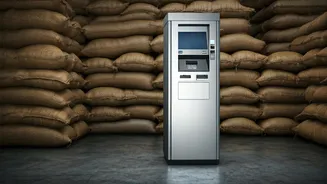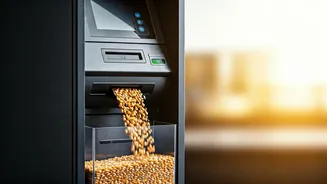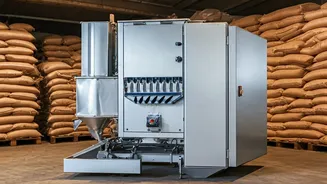What are Grain ATMs?
Grain ATMs, also known as automated grain dispensing machines, are essentially self-service kiosks designed to provide subsidized or free grains to beneficiaries.
They resemble regular ATMs but dispense measured quantities of grains like rice, wheat, and pulses instead of cash. These machines are often connected to a central server that tracks transactions and manages inventory. Beneficiaries typically use a biometric identification system, such as a fingerprint scan, to access their entitled ration. The machine then dispenses the specified amount of grain, ensuring fair and transparent distribution. This automated approach aims to reduce leakages, prevent pilferage, and streamline the public distribution system (PDS), which is a crucial aspect of food security initiatives. The technology facilitates a more efficient and accountable system for distributing essential food items to those who need it most.
How They Function
The operational framework of Grain ATMs is quite straightforward, designed for ease of use. Initially, beneficiaries must register their details, including their biometric information, with the relevant authorities. This registration process is vital for verifying eligibility and preventing misuse of the system. Once registered, individuals can visit the ATM, identify themselves through biometric authentication, and select the type and quantity of grain they are entitled to receive. The machine, equipped with calibrated scales and dispensing mechanisms, accurately measures and dispenses the requested grains. Transaction records are automatically updated in the central server, providing real-time data on stock levels, distribution patterns, and beneficiary usage. This real-time data enables efficient inventory management and helps to identify potential issues such as low stock or discrepancies. Grain ATMs also often have security features, like surveillance cameras, to deter theft and ensure the smooth operation of the entire process.
Benefits of the System
Grain ATMs offer multiple advantages. First and foremost, they enhance the efficiency of the PDS by minimizing human intervention, thus reducing the potential for corruption and diversion of grains. The automated system ensures that the correct amount of grain reaches the intended beneficiaries, eliminating the chances of intermediaries manipulating the distribution process. These machines also save time and effort. Beneficiaries no longer need to wait in long queues at ration shops. Moreover, they provide greater convenience, allowing access to grains at any time, especially when compared with the fixed hours of traditional shops. This is particularly beneficial for working individuals and those with limited mobility. Grain ATMs facilitate transparency by creating a digital record of all transactions, providing accountability and enabling tracking and monitoring. This transparency allows for data-driven decision-making and allows authorities to address any identified irregularities effectively.
Challenges and Concerns
Despite the obvious benefits, the deployment of Grain ATMs faces several hurdles. One significant concern is the cost of installation and maintenance. The initial investment in the machines and the ongoing maintenance costs can be substantial, making it necessary to assess the financial feasibility of their implementation. Furthermore, the reliance on technology raises concerns about digital literacy and accessibility. Many beneficiaries, especially in rural areas, may lack the skills or access to technology to use the machines effectively. Reliable internet connectivity and consistent electricity supply are crucial for the smooth functioning of Grain ATMs, which can be difficult to guarantee in some regions. Data security is another important consideration. Protecting beneficiary information and preventing unauthorized access to the system are essential to ensure the integrity of the distribution process. Addressing these challenges requires careful planning, investment in infrastructure, and effective training programs to ensure the successful implementation of Grain ATMs and maximize their impact on food security.
Looking Ahead
The integration of Grain ATMs into India's food security framework holds significant promise. Continued research and development, along with pilot projects, are essential to refine the technology and address any challenges that arise. Government initiatives, along with community engagement, are important. The government must focus on creating awareness and support among the beneficiaries. Training programs can help to ensure that the system is accessible and user-friendly for all. Collaboration between various stakeholders, including government bodies, technology providers, and community organizations, will be crucial. This collective approach will help in optimizing the implementation of Grain ATMs and in creating a more efficient, transparent, and equitable food distribution system. Ultimately, the successful deployment of Grain ATMs could significantly contribute to improving food security and empowering vulnerable communities across India.

















